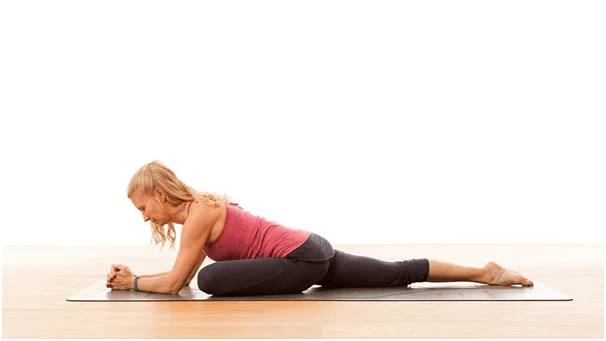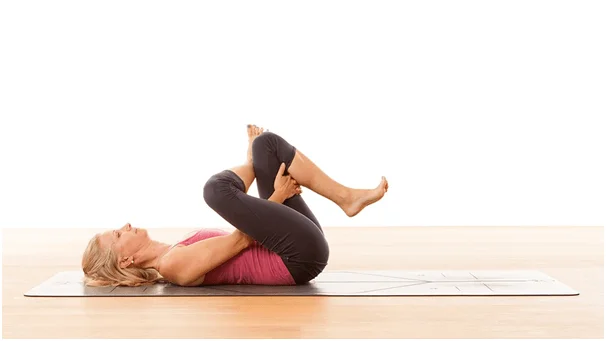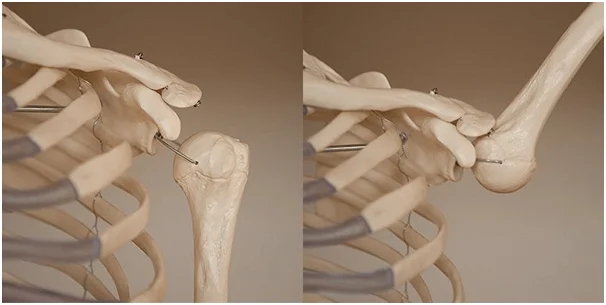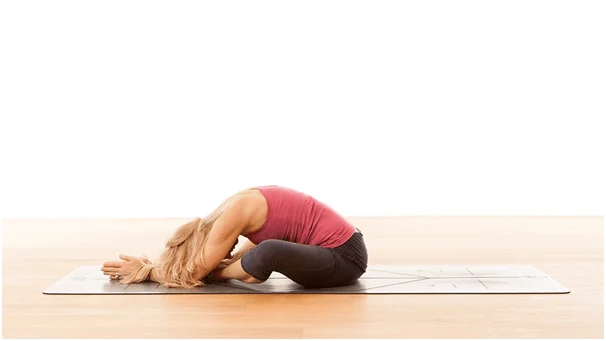https://www.ekhartyoga.com/articles/tension-versus-compression-in-yoga – by Esther Ekhart
Have you ever wondered why, after years of dedicated yoga practice, you are still not able to realise that elusive pose?
Have you ever considered that this may be more to do with the structure of your body and less to do with lack of ‘effort’ on your behalf? How liberating would this knowledge be?
In this article I would like to explain the anatomical concepts of tension and compression and how they relate to our yoga practice.
Knowing the difference between tension and compression and knowing how to recognize when a restriction you feel in the body is caused by tension or by compression, can and will completely change the way you practice your yoga. Not a small thing. So please – read this carefully, remember it and apply it to your practice.
As a student of yoga this information is important to keep your body safe and to understand and value your body in a new way. For yoga teachers this is valuable information to work with. You will begin to understand that a yoga pose is alive. A yoga pose translates itself into different expressions of the same pose through different bodies and, crucially, all of the yoga practice in the world may not transform this expression into the pose you see in the yoga book.
One body simply cannot do the exact same as another body can. Yet so many of us still think that with enough practice we should eventually all be able to look the same in a yoga pose. This is a myth – one that needs to be released to be able to both enjoy your practice and to make it a safe one!
Any restriction you feel in the body doing yoga may be one of 2 things:
1. Tension
Which is the sensation of tissues, such as muscles and ligaments, being stimulated. We are all familiar with the sensation of a stretch and the sensation of something opening, but contraction and twisting also relate to tension (stimulated tissue).
or
2. Compression
Which is the sensation of tissues being pressed or pushed together. This can happen because bone hits bone, squeezing whatever is in between. Compression occurs in both Yin and Yang practices.
When the restriction is tension:
This means that over time, when we stretch lovingly, allowing the body to release tension and open more and more, the body will become more flexible. When this is the case you may get close to the asana shown in the book.
This doesn’t mean you can just push through muscle tension, thinking you should be able to go deeper. Your body is like a little child; if you push it too much it will close down more to protect itself. However, if you gently and lovingly stretch the boundaries, a little at a time, still respecting its boundaries, your body will respond positively by releasing tension and opening more. This optimum place of stretch is often called “the sweet spot”.
When the restriction is compression:
This means that you have hit a boundary that won’t and cannot change over time. This is the skeletal structure of your body reaching its limit: bone hits bone.
The restriction you encounter due to the end of the range of motion of your bones will vary in all bodies, because we all have different sized and shaped bones which relate differently to one another depending on each person. When two bones meet each other, and compression occurs, you simply can’t move any further in that direction. Forcing it will most likely result in injury. Years of practice are not going to change this. When bone hits bone, or presses the tissue between – this is it!
It can result in frustration when you hit that point of restriction that doesn’t seem to give – especially when you don’t realise that it is your bone structure (not lack of effort or dedication!) that stops you from going further. You do yoga for years and years and nothing seems to move, while your friend has landed at the “perfect” pose already. Imagine the relief knowing that there is nothing you can do or haven’t done yet that will change this; it’s just the way you are built. Finally you can give up working towards the “perfect” pose that you will never reach.
Instead of putting your energy and efforts into getting somewhere, and following the mind’s tendency to always go further, you can now start practicing a much more advanced form of yoga – the yoga of acceptance and being present to how it is. You can start to feel the energetic presence of the pose, you can begin to observe the flow of energy through the body, you can begin to feel the emotional quality, or the spiritual significance of the pose. There is a whole world to discover in just being where you are…
In a nutshell, yoga has not ended when you have reached your limit in a pose; it has just begun.
Also good to note is that compression is not bad. It’s ok to feel compression, but it should never hurt! Wanting to go further, whatever the cost, will only result in injury. However, regularly practicing your full range of motion helps you to maintain this full range of motion. So by all means find your boundaries, but above all, respect them.
Another benefit of experiencing compression (particularly in Yin Yoga when you hold poses for 3-5 minutes at a time) is that you stimulate the vitality and mobility of the energy body coursing through those tissues. An effective way to stimulate the meridian system is to push on or pull the connective tissue. You increase the flow of chi / life energy and the body begins to balance and heal.
Why it is important to know when you hit compression.
First of all it helps you to avoid injuries in your yoga practice. Secondly it helps you realize that the point of compression might prematurely stop you from accessing the part of your body you are looking to stretch. You can then stop, accept and give yourself the opportunity to be ok with it. You can also change the way you do a pose, or decide to practice a completely different pose that suits your body better. This way you may still be able to stretch that particular area you wanted to target – just via a different route.
Sometimes there are ways around compression. Moving a bone out or in, or changing the angle of your body can allow you to bypass a point of compression and to find another pathway that is freer. It’s helpful to be open to exploring other ways of stretching the targeted body part and for this to happen you, or the teacher, need an understanding of why you are practicing a certain pose and what the function of that pose is.
Let’s use the outer hips as an example.

When your particular body structure doesn’t support one pose to stretch the outer hips, you could try another pose. For example, when practising Pigeon pose if the hips are tight then the stretch will be felt in the knees instead, which can cause pain, or worse, injury.
If this happens, it’s a better idea to perform Eye of the Needle pose (below) instead until the hips have opened up more and Pigeon pose becomes both safe and enjoyable.

How to recognize whether the restriction you feel in your body is because of tension or compression?
A visual is always extremely helpful. If you look at the picture of the bones of the shoulder and the upper arm bone, you can see that when you lift the upper arm bone the humerus (which is the upper arm bone) hits the bony shelf (acromion process) hanging above it. This is compression. Pushing, pulling or holding the stretch for 5 minutes will not make a difference when one bone hits the other. This happens at different places in different bodies simply because our skeletons are different shapes: one person can lift the arm all the way up and back and they will experience compression very late on. Another person might already feel the sensation of compression by lifting the arm a little higher than halfway up.

Looking at a picture can help you to visualise where you will feel compression in the shoulder. If you feel the restriction in the chest, or inner upper arm, you could call it tension. You now know that over time this tension will release with enough exercise. However, if you feel the restriction in the top of the shoulder, it is compression.
Knowing where these sites of compression can occur, and visualising these points in the body, can help you to determine whether the restriction you feel is tension or compression.
Paul Grilley has an excellent DVD called “Anatomy for Yoga” which pinpoints these joint sites in the body where compression is likely to occur.
There is another way to determine tension and compression. When you feel the restriction in the direction you are moving towards, you are encountering compression. When you feel the restriction in the direction you are moving away from, this is usually tension.
To experience this try Butterfly Pose.

In this pose the knees move towards the floor, so the direction of movement is downwards and outwards. If you feel the restriction in the outer hips (moving towards the outer side of the legs) this is compression. When you feel the restriction in the inner thighs (i.e. moving away from the inner thighs) this is tension.
Another way of saying this is that you are most likely to feel tension in the area that you hope to open/stretch, in this case the inner thighs. You are most likely to experience compression where two body parts move towards each other.
Wrapping it all up
Have you heard the Serenity prayer? It is actually very applicable to understanding the importance and the difference between compression and tension.
The Serenity prayer:
“God, grant me the serenity to accept the things I cannot change, (compression)
The courage to change the things I can, (tension)
And the wisdom to know the difference.”
Ask yourself as a rule in your yoga practice when you encounter restriction, “Is this due to compression or tension, compression or tension…?” Then you can decide on a wise course of action from there.
Please remember though – true yoga is not about getting anywhere, but about accepting/welcoming where you are right now. True yoga is about being present. However, when you are present and have accepted and still the urge arises to work towards something just for fun, you may as well know when you can and when you cannot …!
With love,
Esther

